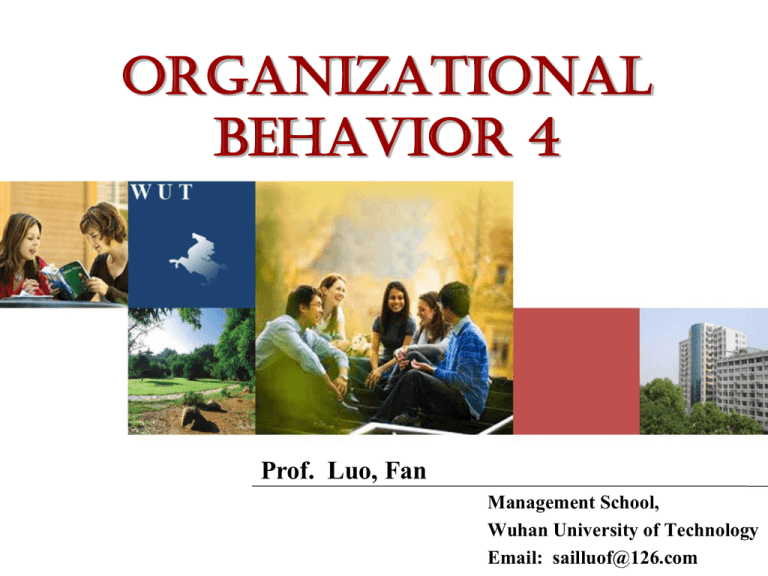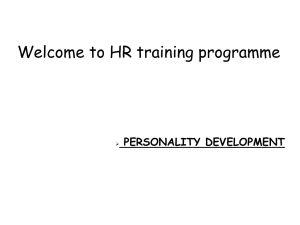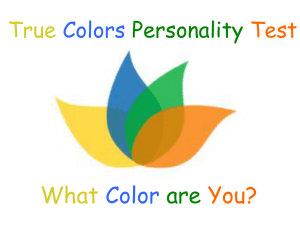
Organizational
Behavior 4
Prof. Luo, Fan
Management School,
Wuhan University of Technology
Email: sailluof@126.com
4. Personality and Values
Case: Why did he lose his job?
Questions:
How about his Personality?
Can he change his Personality?
4. Personality and Values
1
What is Personality
2
Theories of Personality
3
Measuring Personality
4
Personality Fit
5
Theories of Values
Management School, Wuhan University of Technology
Teaching Plan
Objects
Help the students understanding the theories of
personality and measuring personality. Help the
students understanding value theories.
Teaching Emphases
Theories of Personality; Hofstede’s Framework for
Assessing Cultures
Learning difficulty
Measuring personality
Methods
Psychology Test , Lecture; Case discussion; Team
training
(1) What is Personality
Personality
人格
Definition 1: The consistent psychological
pattern within an individual that affects the
way he or she interacts with others and
situations.
Definition 2: The sum total of ways in which
an individual reacts and interacts with others,
measurable traits a person exhibits.
Definition 3
A stable set of characteristics and
tendencies that determine those
commonalties and differences in the
psychological behavior (thoughts, feeling
and actions) of people that have
continuity in time and that may not be
easily understood as the sole result of the
social and biological pressures of the
moment.
PERSONALITY
Overview - factors that shape personality
development
hereditary/biological
environmental/family, culture
nature/nurture interaction
identical twin studies
Personality Determinants
Heredity
Personality
Company Logo
Environment
Situatio
n
Personality Determinants
www.themegallery.com
Types of temperament
Hippocrates Theory
Sanguine
Extraversion
Flexible
Changeful
Choleric
Phlegmatic
Melancholic
Extraversion
Introversion
Introversion
Impulsive
Calm
Sensitive
energetic
Sensible
Unbelieving
E X H I B I T 4–1
Management School, Wuhan University of Technology
(2) Theories of Personality
Psychoanalytic theory
精神分析论
id
ego
supe
r ego
Theories of Personality人格理论
Paranoid
Depressive
Dysfunctional
Personality/Organization
Schizoid
Combinations
Compulsive
Theories of Personality人格理论
Trait theory 特质论
Type theory 类型论
--- theory of body
体形论
--- theory of psychological types
心理类型论
BIG FIVE
Extroversion:
大五因素人格结构
Outgoing, talkative, sociable, assertive
Agreeableness:
Trusting, good natured, cooperative, soft
hearted
Conscientiousness:
Dependable, responsible, achievement
oriented, persistent
Emotional stability:
Relaxed, secure, unworried
Openness to experience:
Intellectual, imaginative,
curious, broad minded
Big Five
Low Scorers
Extroversion
Agreeableness
Conscientiousness
High Scorers
Lone
Quiet
Passive
Reserved
Joiner
Talkative
Active
Affectionate
Suspicious
Critical
Ruthless
Irritable
Trusting
Lenient
Soft-hearted
Good-nature
Negligent
Lazy
Disorganized
Late
Conscientious
Hard-working
Well-organized
Punctual
Big Five
Emotional
stability
Openness
Low Scorers
High Scorers
Calm
Even-tempered
Comfortable
Unemotional
Worried
Temperamental
Self-conscious
Emotional
Down-to-earth
Uncreative
Conventional
Uncurious
Imaginative
Creative
Original
Curious
Psychology Test
What is your personality?
Questions:
1. How did you score? Are you surprised
by your score?
2. What are your personality traits?
3. Was your personality suitable for your
job before you came to China?
Jung’s Psychological Type
容格的心理类型论
Your Mental Processes (精神活动过程)
感知Perceiving
感觉
Sensing
直觉
Intuition
外向Extraversion
判断Judging
思考
Thinking
情感
Feeling
内向Introversion
(3) Measuring Personality
Self-Report Surveys
Observer-Rating Surveys
Projective Measures
Rorschach Inkblot Test
Thematic Apperception Test
TAT (Thematic Apperception Test)
E X H I B I T 4–2
What is Personality Trait
Personality trait is enduring characteristics that describe an
individual’s behavior.
• Cattell’s factor theory of personality(卡特尔的人格因素论)
---surface trait(表面特质)
---source trait(根源特质)
• The “Big Five”Model
16PF
16PF (Sixteen Personality Factors)
个性特征
根源特质
表面特性
A
乐群性
Reserved-------------------------------------------------Outgoing
B
聪慧性
Less intelligent--------------------------------- More intelligent
C
稳定性
Affected by feelings-----------------------Emotionally stable
E
恃强性
Submissive---------------------------------------------- Dominant
F
兴奋性
Serious--------------------------------------------Happy-go-lucky
G
有恒性
Expedient----------------------- -------------------Conscientious
H
敢为性
Timid------------------------------------------------Venturesome
I
敏感性
Tough-minded-------------------- ---------------------Sensitive
L
怀疑性
Trusting-------------------------------------------------Suspicious
M
幻想性
Practical-----------------------------------------------Imaginative
N
世故性
Forthright--------------------------------------------------Shrewd
O
忧虑性
Self-assured----------------------------------------Apprehensive
Q1
实验性
Conservative--------------------------------------Experimenting
Q2
独立性
Group-dependent---------------------------------Self-sufficient
Q3
自律性
Uncontrolled-------------------------------------------Controlled
Q4
紧张性
Relaxed--------------------------------------------------------Tense
Evaluating Trait
Three Major Criticisms:
Lack of explanation
Stability versus change
Situational determinants
MBTI
MBTI: The Myers-Briggs type Indicator
Type of test: Personality Test
Source: Jung’s theory of psychological types
Method of test: Self-report method
Help:
Understand yourself, your motivations, your strengths
and potential areas.
understand and appreciate those who differ from you.
Enhance cooperation and productivity
MBTI
Myers-Briggs Type Indicator
MBTI is a self-report questionnaire designed to make
Jung’s theory of psychological types understandable
and useful in everyday life. MBTI results describe
valuable differences between normal,healthy peopledifferences that can be the source of much
misunderstanding and miscommunication
*Robbins text: More than 2 million people a year take
the MBTI in USA
Dimensions of Jung’s Psychological Type
Does the person’s interest flow mainly to the
E
EXTROVERSION
INTROVERSION
I
Does the person prefer to perceive
S
SENSING
INTUITION
N
Does the person prefer to make judgments or decisions
T
J
THINKING
FEELING
Does the person prefer to live
JUDGMENT
PERCEPTION
F
P
Where do you prefer to focus you attention?
The EI scale
E :Extraversion
Attuned to external
environment
Prefer to communicate by
talking
Learn best through doing or
discussing
Breath of interests
Tend to speak first,reflect later
Sociable and expressive
Take initiative in work and
relationships
I: Introversion
Drawn to their inner worlds
Prefer to communicate by
writing
Learn best by reflection,
mental practice
Depth of interests
Tend to reflect before acting
or speaking
Private and contained
Focus readily
How do you Take-in information,Discover things ?
The SN Scale
N: Intuition
S: Sensing
Focus on what is real and
actual
Value practical applications
Factual and concrete, notice
details
Observe and remember
sequentially
Present-oriented
Want information step-by-step
Trust experience
Focus on “big picture,”
possibilities
Value imaginative insight
Abstract and theoretical
See patterns and meaning in
facts
Future-oriented
Jump around ,leap in
anywhere
Trust inspiration
How do you make decision?
The TF Scale
F: Feeling
T: Thinking
Analytical
Logical problem-solvers
Use cause-and –effect reasoning
“ Tough-minded”
Strive for impersonal, objective
truth
Reasonable
Fair
Sympathetic
Assess impact on people
Guided by personal values
“Tender-hearted”
Strive for harmony and
individual validation
Compassionate
Accepting
How do you orient toward the outer world ?
The JP scale
J: Judging
Scheduled
Organized
Systematic
Methodical
Plan
Like closure-to have things
decided
Avoid last-minute stresses
P: Perceiving
Spontaneous
Open-ended
Casual
Flexible
Adapt
Like things loose and open to
change
Feel energized by last-minute
pressures
What is your type ?
ISTJ
ISFJ
INFJ
INTJ
ISTP
ISFP
INFP
INTP
ESTP
ESFP
ENFP
ENTP
ESTJ
ESFJ
ENFJ
ENTJ
Temperament and occupations
SP
SJ
NT
NF
Performers
Managers
Scientists
Counselors
Entrepreneurs
Accountants
Architects
Journalists
Troubleshooters
Police
Engineers
Artists
One-person
Dentists
Designers
Psychologists
businesses
Teachers
Managers
Clergy
Rescue teams
The uses of MBTI
Self-development
Career development and exploration
Team building
Management and leadership training
Major Personality Attributes Influencing
OB
Core Self-Evaluation
Self-Esteem
Locus of Control
Machiavellianism
Narcissism
Self-Monitoring
Risk Taking
Type A vs. Type B Personality
Proactive Personality
Two Main Components
Self-Esteem
Individuals’ degree of liking or disliking themselves
Locus of Control
The degree to which people believe they are masters of
their own fate
•Internals (Internal locus of control)
Individuals who believe that they control what
happens to them
•Externals (External locus of control)
Individuals who believe that what happens to them
is controlled by outside forces such as luck or
chance
Machiavellianism
Machiavellianism (Mach)
Degree to which an individual is pragmatic,
maintains emotional distance, and believes that
ends can justify means
Conditions Favoring High Machs
• Direct interaction with others
• Minimal rules and regulations
• Emotions distract for others
Narcissism
A Narcissistic Person
• Has grandiose sense of self-importance
• Requires excessive admiration
• Has a sense of entitlement
• Is arrogant
• Tends to be rated as less effective
Self-Monitoring
Self-Monitoring
A personality trait that measures an
individual’s ability to adjust his or
her behavior to external, situational
factors
High Self-Monitors
• Receive better performance
ratings
• Likely to emerge as leaders
• Show less commitment to their
organizations
Risk-Taking
High Risk-Taking Managers
Make quicker decisions
Use less information to make decisions
Operate in smaller and more entrepreneurial
organizations
Low Risk-Taking Managers
Are slower to make decisions
Require more information before making decisions
Exist in larger organizations with stable environments
Risk Propensity
Aligning managers’ risk-taking propensity to job
requirements should be beneficial to organizations
Personality Types
Type As
1.
2.
3.
4.
5.
Are always moving, walking, and eating rapidly
Feel impatient with the rate at which most events take place
Strive to think or do two or more things at once
Cannot cope with leisure time
Are obsessed with numbers, measuring their success in terms
of how many or how much of everything they acquire
Type Bs
1. Never suffer from a sense of time urgency with its
accompanying impatience
2. Feel no need to display or discuss either their achievements or
accomplishments
3. Play for fun and relaxation, rather than to exhibit their
superiority at any cost
4. Can relax without guilt
Personality Types
Proactive Personality
Identifies opportunities, shows
initiative, takes action, and
perseveres until meaningful
change occurs
Creates positive change in the
environment, regardless or
even in spite of constraints or
obstacles
(4) Personality Fit
Holland’s typology of personality and
congruent occupations
Personality-job fit
Personality-organization fit
The key issue of organizational culture
Implications for organizational change
The “good news” and “bad news” of strong
cultures
Achieving Person-Job Fit
Personality-Job Fit
Theory (Holland)
Identifies six personality
types and proposes that
the fit between personality
type and occupational
environment determines
satisfaction and turnover.
Personality Types
• Realistic
• Investigative
• Social
• Conventional
• Enterprising
• Artistic
Holland’s
Typology of
Personality
and
Congruent
Occupations
E X H I B I T 4–3
Relationships
among
Occupational
Personality
Types
Source: Reprinted by special permission of the publisher, Psychological
Assessment Resources, Inc., from Making Vocational Choices, copyright 1973,
1985, 1992 by Psychological Assessment Resources, Inc. All rights reserved.
E X H I B I T 4–4
Technical Standard
Reliability (信度)---The degree to which a measure is
consistent over time.
Validity (效度)---The degree to which a research study
is actually measuring what it claim to be measuring.
Emotional Intelligence (EI)
EI refers to an assortment of noncognitive skills,
capabilities, and competencies that a person’s
ability to succeed in coping with environmental
demands and pressures.
(5) Theories of Values
A specific mode of conduct or end-state of
existence is personally or socially preferable to
an opposite or converse mode of conduct or
end-state of existence.
What did Values come from?
Inherit
National culture
The parents’ behavior
The teachers and friends
The other environment factors
Rokeach Value Survey (RVS)
罗克奇价值观调查
Terminal values(终极价值观):
Desirable end-states of existence;
The goals that a person would like to achieve
during his lifetime.
Instrumental values(工具价值观):
Preferable modes of behavior;
Means of achieving the terminal values.
The Manager’s Values
Terminal values
Instrumental values
self-esteem
Honest
Family security
Responsible
Freedom
Capable
A sense of accomplishment
Ambitious
Happiness
Independent
Hofstede’s Framework for Assessing
Cultures
Power Distance
The extent to which a society accepts that
power in institutions and organizations is
distributed unequally.
low distance: relatively equal distribution
high distance: extremely unequal distribution
Hofstede’s Framework (cont’d)
Individualism
Collectivism
The degree to which
people prefer to act as
individuals rather than
a member of groups.
A tight social framework in
which people expect
others in groups of which
they are a part to look
after them and protect
them.
Hofstede’s Framework (cont’d)
Achievement
The extent to which societal values are
characterized by assertiveness, materialism and
competition.
Nurturing
The extent to which societal values emphasize
relationships and concern for others.
Hofstede’s Framework (cont’d)
Uncertainty Avoidance
The extent to which a society feels threatened
by uncertain and ambiguous situations and tries
to avoid them.
Hofstede’s Framework (cont’d)
Long-term Orientation
A national culture attribute that emphasizes the
future, thrift, and persistence.
Short-term Orientation
A national culture attribute that emphasizes the
past and present, respect for tradition, and
fulfilling social obligations.
Key words
personality
Ability
16 personality factors
Big five model
Locus of control
Self-esteem
Type A personality
Machiavelliansm
Holland’s typology of personality
Team Exercise
What Organizational Culture Do You
Prefer? (P163)
The Organizational Culture Profile (OCP) can help
assess whether an individual’s values match the
organization’s.
The OCP helps individuals sort their characteristics in
terms of importance, which indicates what a person
values.
1. Working on your own, complete the OCP found at
www.jstor.org/stable/256404 .
2. Your instructor may ask you the following questions
individually or as a group of three or four students.
Questions:
a. What were your most preferred and least preferred
values? Do you think your most preferred and least
preferred values are similar to those of other class
or group members?
b. Do you think there are generational differences in
the most preferred and least preferred values?
c. Research has shown that individuals tend to be
happier, and perform better, when their OCP
values match those of their employer. How important
do you think a “values match” is when you’re
deciding where you want to work?
Evaluation for Team Exercise
1. Preparing work and cooperation
2. Contents with OB theories and practice
3. Quality of presentation
4. Questions and answers
Total
20
30
30
20
100
Wuhan University of Technology
Email: sailluof@126.com










